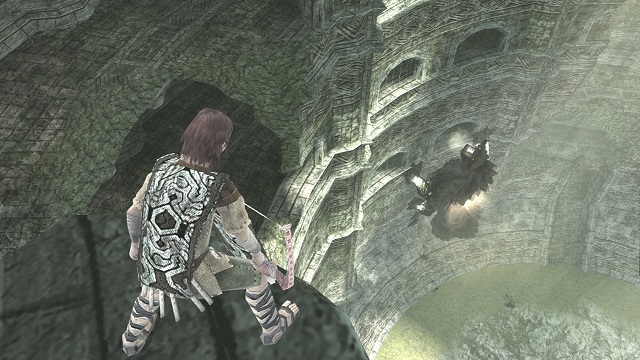So we’ve got a horny boy, a lonely guy, and a horse… What? Why are you looking at me like that?
As a general rule, video games are not like wine: They don’t get better with age. Okay, you could argue that all this new-age mumbo jumbo with patches and DLC might accomplish that, but you can’t do that for the classics, and shut up, you’re ruining my opening paragraph.
At best, they simply do not degrade, as in the case of Ocarina of Time; at worst, the years of technological advancement and gameplay refinement can exacerbate the flaws that we may have overlooked or simply tolerated once upon a time. I suppose in that case, the wine analogy still fits—it just turns to vinegar.
Now, ICO and Shadow of the Colossus are certainly not vinegar, not by a long shot—both excellent games well worthy of the heaps of praise bestowed upon them in the years since their initial release. Unlike the aforementioned Ocarina of Time, however, they are not immune to the weathering effects of age.
It’s more apparent in ICO, being the older of the two siblings. I imagine that someone who played this game back in the day and was completely blown away by the elegant puzzles, entrancing atmosphere, and the wonderfully minimalist approach to storytelling would find it all too easy to look upon this HD port and forgive most of the technical issues. That’s why I feel it’s fortunate for this review that I haven’t.
Without any nostalgia-tinted goggles on, the flaws are plain as day. Character animations are laughably jerky, the Fixed Camera of Doom too often manages to park itself in frustrating spots (like so many games of that era), and combat is an intensely boring button-mashing affair of executing the same three-hit combo over and over again until the nasty black shadow things are dead.

And while it’s my job to do so, it pains me a little to point these things out. ICO is a very good game, and as a piece of art, it gets everything right. It is unequivocally a classic of the PS2 stable, albeit one that is showing its age. Though I risk excessive flaming from the game’s cult following, I am somewhat disappointed that they didn’t just remake the whole enchilada instead of simply porting the original and spooning some HD sauce over it.
And then there’s Shadow of the Colossus, ICO’s spiritual successor and chronological prequel. I also missed this game the first time around, and oh, how I regret it. While it, too, suffers slightly from aging, though not nearly as much, Shadow is the same dazzling spectacle of gaming at its finest today as it was back in 2005.
In a way, I’m still glad I didn’t play it until now—the frame-rate issues that plagued the PS2 incarnation are entirely gone and the game runs at a steady 30 fps whether you’re galloping on the plains or holding a thrashing colossus’s mane for dear life. This is Shadow of the Colossus the way it was always meant to be.
Horseback controls are still finicky, although after a couple hours, I was quite comfortable with the unique way that Agro moves; my only real annoyance is you have to consistently mash the X button, often for minutes at a time, just to get him going. As with Ico, Wander’s animations can look oddly jerky, and there are still occasional camera problems that obscure your sight or make you jump in weird directions.

It’s also worth mentioning that the HD treatment doesn’t hide the fact that these are PS2 games. Some of the more breathtaking Colossi battles almost look good enough to be PS3 quality, but by and large there are plenty of blurry textures in both games to remind you of their humble origins. The HD helps the most when you’re looking out at grand vistas and get a glimpse of the impressive view distances that these versions pull off.
You may have noticed that I haven’t gone into the stories at all, and that’s intentional. I could give you a bare framing of them, but you could easily get the same effect from watching the opening cut-scenes. And since the stories are so paramount to both of these games (not necessarily in terms of what is being told so much as how), relying heavily upon the way that each individual player receives and interprets the events on-screen, merely dropping basic plot points here feels like a disservice to both the player and the developers.
Looking back over this review, I almost regret including the negative points, because I don’t want to give a false impression here. These two games make a superb collection which I highly recommend at a mere $40. Even if you already own copies of both games, you’d do well to pick it up for the HD, stereoscopic 3D, and Trophy support at such a bargain price.
-
Two classic games; one sweet price!
-
You won’t find games more artistic than these
-
Impressive distance visuals, blurry textures up close
-
Killing colossi is still just as amazing
-
Combat in ICO is not
-
Jerky animations and old-school camera issues







